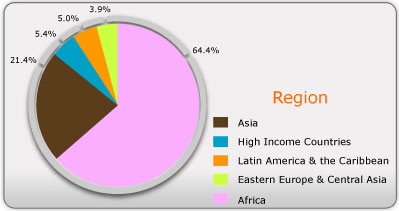Health Care Management: HIV and AIDS Prevention and Treatment Essay
Introduction
To define the measurement system, and define the failure or success of HIV/AIDS treatment it is necessary to give the image of the situation in general. By the estimations from the UNAIDS 2008 Report on the global AIDS epidemic, nearly 30.8 million adults and 2 million children had HIV at the end of 2007. Unfortunately, the data on the later periods is not available, however, it is hardly probable that these rates have decreased by the present time. Globally, the statistics are the following: nearly 11% are babies who get infections from their mothers. 10% – injecting drug users, 5 – 10% get an infection because of homosexual contacts, the same rate is for medical carelessness, and the rest proportion (two-thirds of all infections) are caused by heterosexual contacts. (Potter, 2008)
Originally, 95% of the infected people are from the developing world and the Third World Countries. And the proportion tends to increase even faster than the common proportion of infected vs. uninfected due to poor medication, limited resources for prevention and care.

Figure 1. Region.
It is emphasized that any forecasts on the matters of HIV/AIDS epidemic spread can not be made, but only approximate expectations. The fact is that it fully depends on the actions taken. In some projects the governments define AIDS as much more than just an issue of health care, consequently, HIV spread eventually reduces; in other cases, positive intentions tend to fail, as the governments are just able to deliver some short-term responses. Such responses are widely spread in the developing countries which are the worst-affected, and the amount of infected people essentially increases.
The World Health Organization does not issue the rates of HIV infected, however, it provides the statistics on AIDS mortal cases. The annual number of victims of AIDS is expected to increase up to 2.4 million in 2012, and then fall to 1.2 million in 2030. However, even this scenario represents HIV/AIDS as one of the ten leading reasons for death all over the world. (Martinez-Donate, Hovell, Zellner, 2004).
Measuring
Measuring the problem is held by several organizations, and the fact, that there is a necessity to define the success or failure, measurement of HIV/AIDS problem is the essential task for defining the tendency. Success or failure depends on the treatment, prevention, and education; consequently, all the factors should be taken into account. In the wide range of decease contexts, the expectancies on the matter of treatment results play the important role in the health behavior of the patients. Originally, in the context of HIV/AIDS curing expectation of the advantages and success of treatment and assurance in one’s capability to adhere to antiretroviral medication (ARV) is closely linked with obedience, which is associated with clinical outcome. (Fernandez, Bowen, Gay, 2003).
There is a powerful concern, which is closely linked with the belief that curing may complicate the spread of HIV. The education may prevent HIV positive to get sexually engaged with those who are not infected, and HIV negative will be more careful while making sex with those whose HIV status is unknown.
To study all these factors it is necessary to measure treatment expectations and perspectives carefully, thoroughly, and accurately, as measures used for previous researches were either concentrated on decease progression, without taking into account the treatment expectations or were not held based on accepted standards. (Seal, Ehrhardt, 2004).
1 hour!
The minimum time our certified writers need to delivera 100% original paper
Understanding the mechanisms of HIV transmission is important for the evaluation of the prevention measures, and, consequently for measuring the success. The doctors of the developed countries generally tell their patients how HIV is transmitted, and what can be done to prevent infecting others. The high-risk behaviors should be discussed. These talks relate to the issues of education, consequently, the higher the education level – the lower the risks for infection, the lower infection rates, and mortalities.
Measurement factors should also entail the worldwide use of prevention tools, medications, and contraceptives. Only by taking into account these factors, we may get the correct and accurate evaluation of the problem.
Prevention and Treatment
Originally, prevention does not mean treatment, as it is aimed to avoid infection, but not to cure it. Prevention is achieved by severa
Order this paper